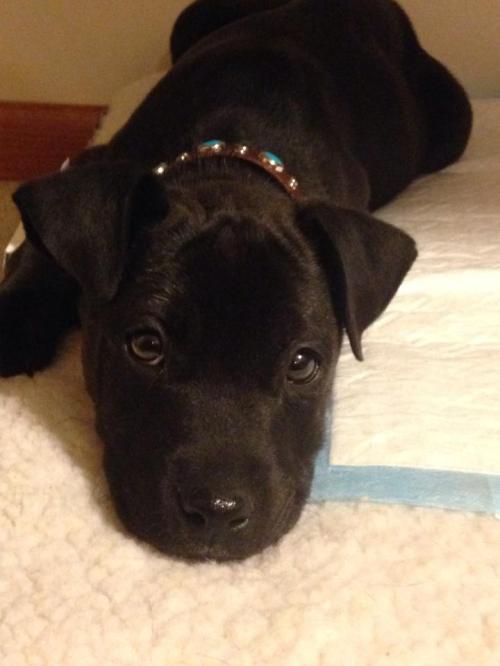There are many different training methods out there, and each has its pros and cons. Today, I want to talk specifically about the use of remote collars (also known as shock collars or e-collars).
Today’s remote collars are a far cry from early versions. Many brands now have a very wide range of shocks (called “stimulations” by collar users), which can range from virtually unnoticeable to intensely painful. “Good” remote collar trainers use the collars primarily as negative reinforcement. What that means is that the dog learns to comply immediately in order to turn off a painful, uncomfortable, or annoying sensation. While this is a far cry from the early days of remote collar use, when dogs were hurt at high levels for noncompliance (a training technique called positive punishment, for you geeks out there), it’s still not a pleasant way to learn.
So, how would someone use a remote collar? Let’s use a recall (come when called) as an example. The trainer would start by asking the dog which level of stimulation was the right one. This is done by putting the collar on the dog and, starting at one, increasing the level until the dog displays a change in behavior. This level is then the one used for initial training, although the trainer may adjust the level up or down depending on a variety of factors. The dog should not be displaying significant signs of pain or distress at this level (no yelping, head shaking, or fight/flight reactions).
Once the “appropriate” level of shock is determined, the trainer will teach the dog to turn off the shock. This can be done in a variety of ways, but usually involves repeated stimulations (tapping the remote over and over rapidly) until the dog moves towards the handler, at which point the shocks stop. The dog learns that his or her behavior can make the sensation stop.
While remote collar training can certainly be effective (if it wasn’t, it wouldn’t still be around), it is not a technique that I recommend. So, what are the common problems with remote collar use?
My biggest concern with the use of these collars is that, used according to modern training directions, there is no way for the dog to avoid shock entirely. The first “tap” of the collar is given simultaneously with the command. While the dog can quickly turn off the sensation by complying, there is no time or way for the dog to entirely avoid all shocks. The dog is only able to avoid future shocks, not the initial one. This necessarily sets up a stressful learning experience.
But what if the collar isn’t used simultaneously with the command? What if, instead, the trainer only begins tapping the remote after the dog has had a few seconds to respond? While this training method would avoid the above issue, it creates other problems. Don’t forget, Pavlov is always on your shoulder! If the recall command is repeatedly followed by an uncomfortable or unpleasant stimulus, you will quickly condition your dog to feel dread when you call. This process is called classical conditioning, and it’s powerful stuff. We call cues that are associated with icky things like this “poisoned” cues, and research shows that changing the association with a poisoned cue is a very long-term, difficult process. Once your dog has associated a word with something unpleasant, they will always have that memory in the back of their mind when they heard the poisoned cue in the future, even if future repetitions of the cue have only been associated with nice things. By the way, this same process happens if you use a warning tone or vibration before (and eventually even in place of) the stimulation.
Speaking of emotions, my second concern has to do with the quadrant of learning theory that remote collar users employ: negative reinforcement. In negative reinforcement, the dog learns to do something in order to stop an unpleasant thing. The primary emotion associated with negative reinforcement is that of relief. People feel this too! Consider doing your taxes, shoveling the driveway after a big snowstorm, or loading the dishwasher. The biggest reward for completing these tasks is the sensation of relief when you’re done. The tasks are not enjoyable in and of themselves, but you feel better when they’re completed because you’ve removed the pressure of the need to act that’s been looming over you.
Compare this to the emotion that positive reinforcement causes: joy! Which would you rather have your dog feel when you call him? When trained with positive reinforcement, the recall cue becomes a tiny reward in and of itself. Dogs feel a little jolt of happiness when you call, because they’ve associated the recall over and over with very pleasant things happening. Dogs who are trained with negative reinforcement, such as remote collars, feel a strong compulsion to move towards you when you call them, followed by a feeling of relief once they are in motion towards you. That’s not the same, and it’s not what I want our relationship to be based on. That’s not to say that dogs trained with remote collars can’t have lovely relationships with their owners – they can! In fact, training of any sort will begin to build a relationship, regardless of methods used. But my opinion is that positive reinforcement works the very fastest and best to build strong, lasting relationships based on mutual respect and understanding.
Finally, remote collars can cause fear or aggression issues. This comes back to that classical conditioning we talked about before. If you repeatedly use the collar to call your dog away from people or other dogs, for example, your dog may come to associate the uncomfortable sensation with what he sees when the collar is activated (dogs or people) rather than with his behavior. If he’s looking at another dog every time he hears the warning beep or gets “tapped,” he’s going to come to associate other dogs with this, and his behavior towards other dogs is likely to change. In fact, this is such a common situation that the AVSAB has released a position statement warning about these risks, and advising that e-collars are never used in dogs who have any history of fearful or aggressive behavior.
But, aren’t remote collars necessary in some situations? What about if your dog lives near a busy road or has a history of chasing livestock? Aren’t e-collars more reliable than positive reinforcement alone? This is one of the most common excuses I hear for using remote collars. Luckily, this question has been studied, and the results were quite conclusive. Positive reinforcement training works every bit as well as remote collar methods in teaching a reliable recall, even for dogs who have a history of chasing livestock. Furthermore, dogs trained with positive reinforcement methods showed fewer signs of stress, such as yawning and tense muscles, and had lower salivary cortisol levels three months later upon visiting the training center. If you feel that you need to use a remote collar to achieve a reliable recall, you likely need a better trainer and better management tools, not a remote collar.
Ultimately, I believe that remote collars are a step up from previous compulsive methods of training dogs, such as using a long leash attached to a slip or pinch collar. But that doesn’t mean that they’re the best method out there, or even a good method, and before using one I would strongly advise you to do your research. Reward-based methods work, even with strong, hard-headed, and highly predatory dogs. In fact, they work really well for all animals, with fewer potential side effects. They can work for you, too.











